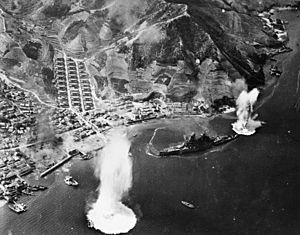Attacks on Kure and the Inland Sea (July 1945) facts for kids
Quick facts for kids Attacks on Kure and the Inland Sea |
|||||||
|---|---|---|---|---|---|---|---|
| Part of the Pacific theatre of World War II | |||||||
 Japanese battleship Haruna under attack on 28 July |
|||||||
|
|||||||
| Belligerents | |||||||
| Commanders and leaders | |||||||
| Units involved | |||||||
|
|||||||
| Casualties and losses | |||||||
| 102 killed 133 aircraft destroyed |
1 fleet carrier sunk 3 battleships sunk 2 heavy cruisers sunk 1 light cruiser sunk 2 armored cruisers sunk 2 escort ships sunk 306 aircraft destroyed 392 aircraft damaged |
||||||
The attacks on Kure and the Inland Sea were a series of air raids in July 1945. These attacks took place during World War II. American and British planes targeted Japanese warships. Most of Japan's remaining large warships were sunk. These attacks happened near Kure, a major Japanese naval base.
The United States Third Fleet attacked Kure and nearby ports. These attacks happened on July 24, 25, and 28. They sank an aircraft carrier, three battleships, and five cruisers. Several smaller warships were also destroyed. At the same time, the British Pacific Fleet attacked other targets. They sank two escort ships and damaged an escort carrier.
Why the Attacks Happened
In July 1945, the Imperial Japanese Navy (IJN) had few large warships left. These ships were gathered near Kure. They couldn't move much because they lacked fuel. So, they were used as stationary anti-aircraft guns.
Admiral John S. McCain, Sr., a US commander, thought attacking Kure was not very important. He believed the Japanese ships were not a big threat. However, Admiral Halsey decided to attack for several reasons:
- He wanted to boost American spirits. It was also a way to get back at Japan for the Attack on Pearl Harbor.
- He wanted to make sure Japan couldn't stop a planned Soviet invasion of Hokkaido.
- He wanted to prevent Japan from using its fleet to get better peace terms.
- His boss, Fleet Admiral Chester W. Nimitz, had ordered the attack.
The British Pacific Fleet was part of the US Third Fleet. But they were not allowed to attack Kure directly. This was because the Americans didn't want Britain to share the credit for destroying the Japanese fleet. Instead, the British attacked airfields and the port of Osaka.
Previous Attacks on Kure
Kure had been attacked several times before July 1945.
- On March 19, 1945, 321 US Navy planes attacked Japanese ships. No ships were sunk, but an escort carrier and a light cruiser were badly damaged.
- On May 5, B-29 Superfortress bombers hit the Hiro Naval Aircraft Factory.
- B-29s also dropped naval mines near the port on March 30 and May 5.
- On July 1, a large air raid by Superfortresses destroyed 40 percent of Kure city.
The American forces involved in the July attacks were part of Task Force 38. The British forces were part of Task Force 37. British carriers included HMS Formidable (67), Indefatigable (R10), and Victorious (R38).
The Battle in July 1945
The US Third Fleet began its attack on Kure on July 24. US carrier planes flew 1,747 missions that day. They sank the aircraft carrier Amagi. They also sank the cruiser Ōyodo. This ship was the flagship for the Japanese fleet.
Many other large ships were badly damaged. These included the battleships Hyūga, Ise, and Haruna. The heavy cruisers Tone and Aoba were also hit. Even older training cruisers like Iwate and Izumo were damaged. These ships settled in shallow water. The water was too shallow for the US planes to use torpedoes. American planes used special bombs to reduce their losses from Japan's many anti-aircraft guns.
The British Pacific Fleet attacked Osaka and other targets. They damaged the escort carrier Kaiyo. They also sank two escort ships, No. 4 and No. 30. The British lost four aircraft in these attacks.
US attacks on Kure continued on July 28. The battleships Ise and Haruna were damaged again. The heavy cruiser Aoba also took more hits. The aircraft carrier Katsuragi was heavily damaged. The unserviceable light aircraft carrier Ryūhō was also attacked. These air strikes were some of the largest by the US Navy during the war. They caused the most damage to Japanese shipping.
On July 28, US Army Air Forces also attacked Kure. 79 B-24 Liberators from Okinawa bombed the ships. The beached cruiser Aoba was hit four times, breaking off its stern. Two B-24s were shot down, and 14 others were damaged.
The Allied forces lost 102 aircrew and 133 planes. These losses were due to combat or accidents. This was a higher loss rate than usual for the US Third Fleet. It showed how strong the anti-aircraft defenses were around Kure.
Aftermath
The attacks on Kure and the Inland Sea were very successful for the Allies. After these attacks, the battleship Nagato at Yokosuka was the only large warship left in Japan.
British historian Stephen Roskill saw the destruction of these ships as revenge. It made up for the losses the United States suffered at Pearl Harbor. The attacks also allowed the Soviet Pacific Fleet to operate safely. They could move in the Sea of Japan without fear of being attacked by Japanese ships.
Gallery
See Also
- Bombing of Kure









